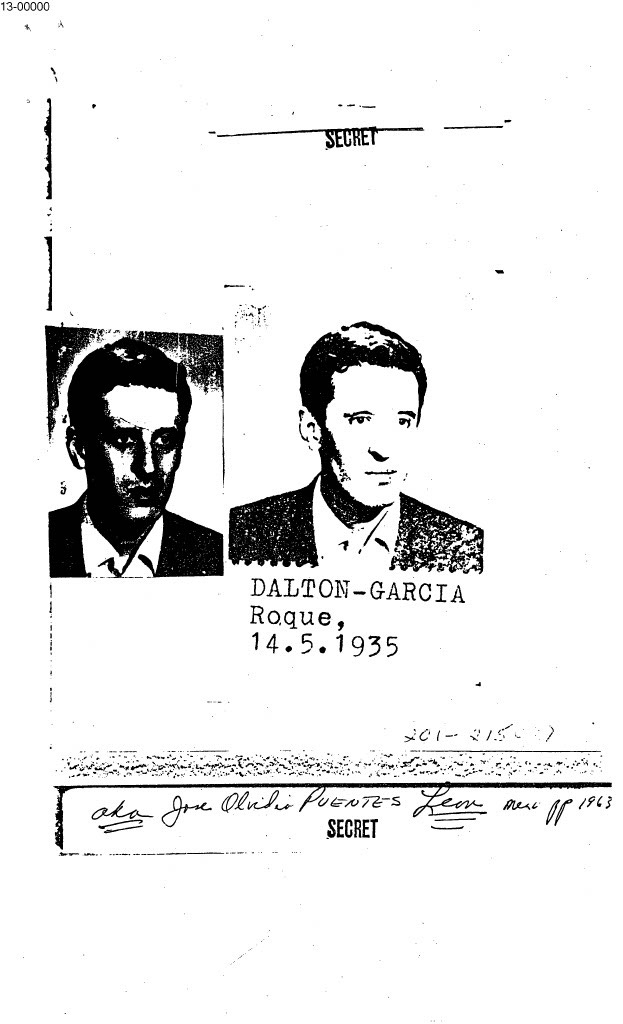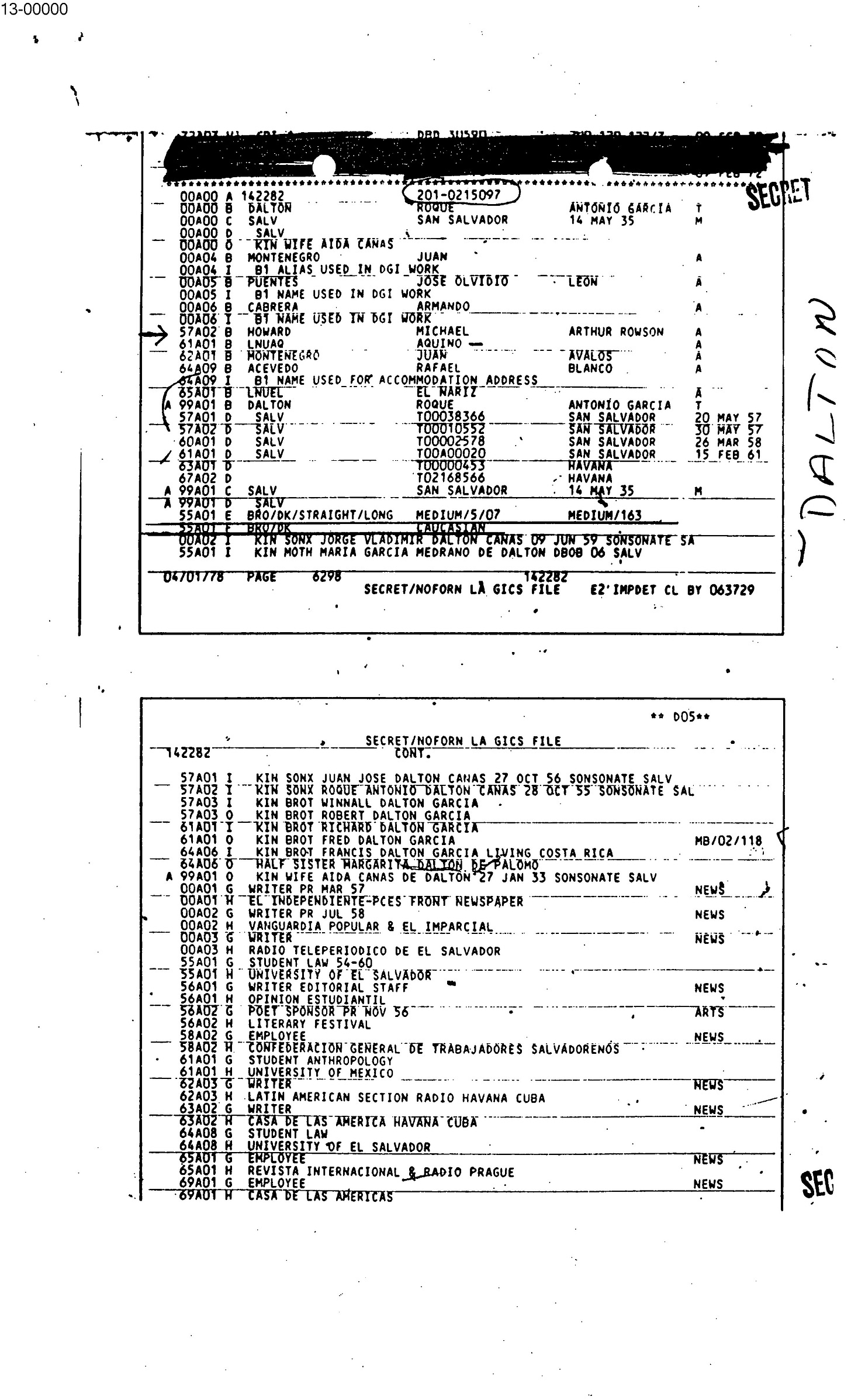Part I: Was Salvadoran Poet, Roque Dalton, involved in the assasination of JFK?
The JFK Assassination Archive holds nearly 100 pages of CIA documents in which the agency tracks, surveilles, and fails to recruit the poet and revolutionary.
No, Roque Dalton, the revolutionary, poet, essayist, journalist, and cachimbón Salvadoreño, had nothing to do with the assassination of the 35th president. Then why are there surveillance documents on Roque held in the JFK assassination archive? Dalton appearing in these files is somewhat old news, but I hadn’t heard about it. So when I started digging around in 2021-22 when additional documents related to the JFK assassination were released (the first document release happened in the early 90’s after the passing of the President John F. Kennedy Assassination Records Collection Act but the act gave a end date of Oct. 26, 2018 to release of all the government archives), the first thing I did was type in “EL SALVADOR” to see what, if anything, came up. And boy, was I surprised.
By my count, there are at least 50 documents, if not more, some of which contain multiple pages documenting Roque’s activities, whereabouts, family members, and notes from interviews conducted by the CIA while he was in prison, something Roque writes about himself in his novel, Pobrecito Poeta Que Era Yo (a book that as far as I know has never been fully translated into English). To return to the original question of why Roque is found throughout the document archive of the JFK assassination, the answer is a bit complex. However, once you get through the complexity, it is incredibly straightforward.
If you aren’t a JFK assassination conspiracy head, this might be more information on the JFK assassination than you would ever want, and to those who are JFK assassination heads, I apologize if I oversimplify some aspects of this.
When Jack Ruby kills Lee Harvey Oswald, the primary suspect of the assassination is gone. This meant authorities wouldn’t be able to extract information from Lee Harvey, they wouldn’t get motivation, and there would certainly be no trial (except for Clay Shaw, a topic for another day). This leads to the creation of a few investigatory commissions and committees over three decades. The Warren Commission, launched immediately after the assassination (concluding that Lee Harvey was the sole actor) and the US House Select Committee on Assasinations a whole decade later, which was prompted by the release of the Zapruder film, and more importantly, the Church Committee’s investigation into abuses committed by the CIA, NSA, FBI, and the IRS. Finally, there is the passing of the JFK Act in 1992 (after the release of Oliver Stone’s JFK film) directing the National Archives and Records Administration to compile and make all documents publicly available within 25 years, as stated earlier. The Church Committee opened the question of whether there was a larger conspiracy that involved the Cubans, and by extension, the Soviets. That question is then taken up by the US House Select Committee. Now, in 2025, with most but not all the records public through NARA, we can see the sheer depth of the CIA’s surveillance apparatus and covert actions, all to undermine and eventually overthrow the Cuban Revolution (a goal that persists until today). And this is where Roque finally comes in.

The Russ Holmes File
The CIA archivist Russell Holmes was the CIA liaison for all inquiries on the assassination after the end of the HSCA investigation until his retirement. He kept extensive files predating the assassination and well after. Those files include documents on Sylvia Odio, a Cuban woman who claims she was visited by 3 men, two Cubans and a gringo. One of the Cubans introduced himself as Leopoldo, the American was introduced to her as Leon. Sylvia Odio would go on and give testimony to the Warren Commission, claiming that this Leon was the very same Lee Harvey Oswald, who technically should have been in Mexico during the time of this visit. In an effort to pinpoint who Leon and Leopoldo are, the CIA looks into every single Cuban Leon found in their records. There was no Leon Oswald to be found. There was a Jose Olividio Puentes LEON. He was a Cuban intelligence agent, according to the CIA, who was better known as the poet Roque Dalton.
This Russ Holmes file is fascinating because it lays out important details about Roque, including his two gold teeth and a list of the pseudonyms he allegedly used as an agent of the Dirección General de Inteligencia (DGI), the Cuban intelligence agency. My favorites are Aquino and Nariz. The former is a reference to the 19th-century indigenous rebel leader of the Nonualcos; the latter references his prominent nose. The file also includes a chronology of “pertinent activities”, starting with his visit to the Soviet Union for the Sixth World Festival of Youth and Students in 1957, alleged military training received in East Germany in 1962, his travel from Prague to Cuba in 1963, and his return to El Salvador that same year which leads to his expulsion to Mexico happening a bit after Kennedy is assassinated at Dealy plaza.
The timeline of activities seems to end in 1971, at least according to this document. It would be a surprise if CIA surveillance of Dalton actually ended there, especially since he goes on to join one of the five factions that would make up the FMLN in 1973, until he is killed by his comrades in 1976. It is more likely that any documents after 1971 remain classified.

There are two other names mentioned in this file that could lead us down two more rabbit holes, something I may cover in the future. The first name is Gilberto Policarpo Lopez, and the other is Miguel Vazquez. A CIA “personality” file was opened on Policarpo Lopez in 1963, according to another JFK document titled “Cuban American”. In the Dalton file, there is a question of whether Roque and Policarpo Lopez had ties to one another. Suspicion is raised around Lopez when he travels back home to Cuba from the US via Mexico just after the Kennedy assassination. He is never heard from again after that. In the file is a picture, a group shot of five men in suits. Above man number one, we see typed out, “Could #1 be Gilberto Policarpo Lopez?” and hand-scrawled above man number three, we see “Dalton?”. I wonder if the question being raised by the CIA here is if the Cuban and the gringo who visited Sylvia Odio in Dallas are Dalton and Policarpo Lopez? Dalton’s father was an American after all. A huge stretch, but I guess it was explored to simply rule it out. There is no evidence that Dalton ever stepped foot in the United States, so it would be impossible for him to be connected to the assassination. Of course, the CIA knew all this. In part two, I’ll explore some other relevant Dalton CIA documents, including those covering failed DGI plots and his run-in with the CIA.
Other Pulgarcito News
This week, El Faro, a Latin American news outlet based in El Salvador, released a three-part video interview series with two members of the Barrio 18 Revolucionarios, one of the two major gangs in El Salvador. One of the most interesting things that came out of these interviews is the gang claiming that the reason why Bukele was elected first as mayor of San Salvador, then as president of El Salvador, was largely due to the activities of the gang itself. The gang was interested in seeing the leftist FMLN government out of power, especially after the second FMLN government declared war on the gangs, moving away from the truce they initially brokered with the two major gangs in the first FMLN government. If this and other claims are true, it would not only severely undermine Bukele’s crusade against gangs but also imply committing similar illegal acts that past government officials were charged with.
Meanwhile, the White House continues to spread negative information on social media and friendly news outlets about Kilmar to justify its treatment of immigrants and political prisoners.
Local Happenings
The penultimate episode of the Over the Loud Speaker YouTube show is now available! This doesn’t mean that we are ending the show after our next episode, just that we are taking a little summer break before we return for “season two”. I’m excited that our audience continues to grow, even after covering niche political nerd topics like municipalism and in this latest episode, proportional representation.
For those of us who live in the unincorporated area of Alameda County, the post office has finally approved the name change of the unincorporated communities to reflect that they are NOT part of San Leandro or Hayward. This has been a long-time struggle to bring more representation and recognition to these communities. It hasn’t happened without ruffling some feathers. For example, some longtime residents are complaining in Facebook forums that their address doesn’t say Hayward anymore, but San Lorenzo. A name change may not seem like a big deal, especially when nothing else substantially changes in how they interact with local government, but I can understand having your identity tied to a specific place and then suddenly having that changed on you.
Before I go, I need to make a plug for Season 2 of Andor. It is such a brilliant show and I love everything about it. It feels like the makers of the show took real political examples and injected them right into the Star Wars universe. The show ends in time for me to write something up on it for my next piece, so that is something to look forward to.
#FREE KILMAR. Peace.





